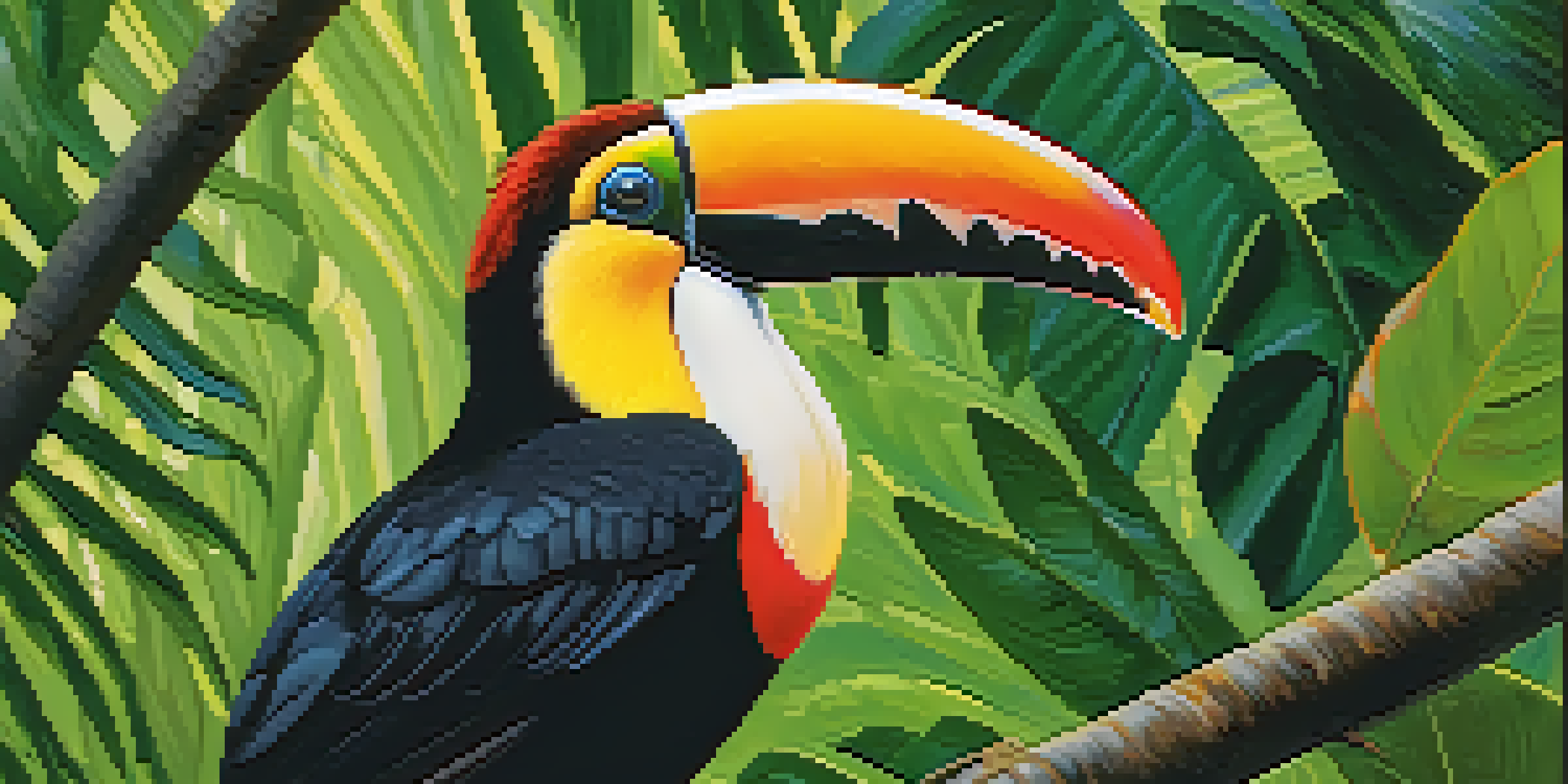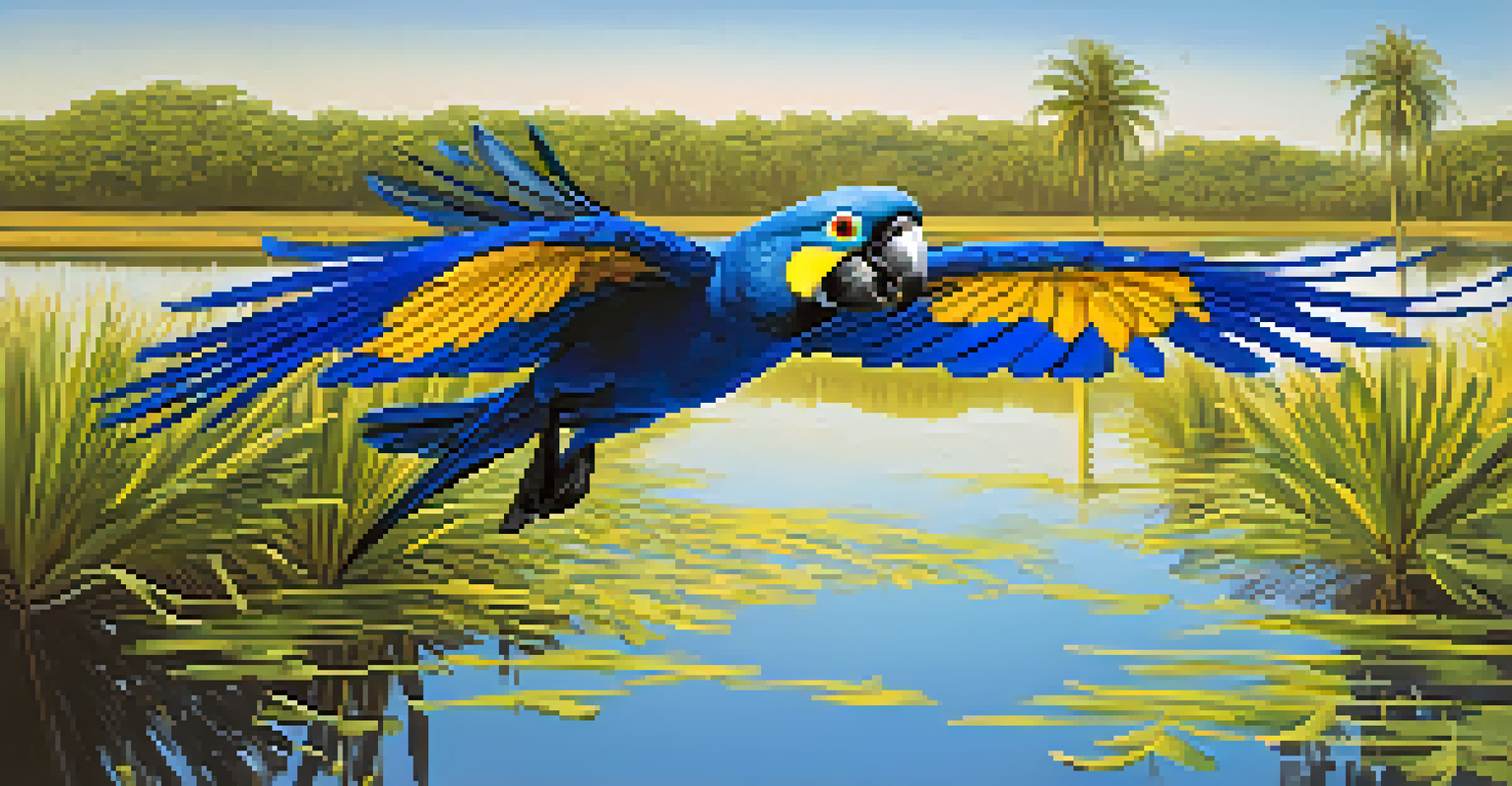Top 5 Bird Species to Spot While Birdwatching in Brazil

The Colorful Toco Toucan: A Brazilian Icon
The Toco Toucan is perhaps one of the most recognizable birds in Brazil, thanks to its vibrant orange beak and striking black feathers. These birds are often seen in tropical forests and are known for their loud calls, which can be heard echoing through the trees. Spotting a Toco Toucan is like finding a piece of living art in the wild, making it a must-see for any birdwatcher.
In every walk with nature one receives far more than he seeks.
Toco Toucans primarily feed on fruits, especially figs, but they will also eat insects and small animals. Their unique beak, which can be up to 8 inches long, helps them reach food high in the canopy. Observing their feeding habits can be quite a spectacle, as they often clumsily maneuver through branches, adding to their charm.
If you're lucky enough to spot a Toco Toucan, make sure to take a moment to appreciate its beauty. These birds are not only visually stunning but also play a vital role in their ecosystem by helping to disperse seeds, contributing to the health of the forest.
The Majestic Hyacinth Macaw: Largest Parrot in the World
The Hyacinth Macaw is the largest species of parrot in the world and is a true marvel to see in the wild. With its brilliant blue plumage and striking yellow eye patches, this bird stands out against Brazil's lush landscapes. Spotting a Hyacinth Macaw is a thrilling experience that many birdwatchers dream of.

These macaws are primarily found in the Pantanal and other areas with palm trees, as they rely on the fruits and nuts from these plants for food. They are highly social creatures, often seen flying in pairs or small groups, creating a lively scene as they glide through the air. Their playful behavior can be quite entertaining to observe.
Toco Toucan: A Vibrant Ecosystem Player
The Toco Toucan's striking appearance and fruit-based diet make it an essential contributor to seed dispersal in tropical forests.
Unfortunately, the Hyacinth Macaw is classified as vulnerable due to habitat loss and the illegal pet trade. While birdwatching, take the time to learn about conservation efforts to protect these magnificent birds and their habitats, ensuring future generations can enjoy their beauty.
The Elegant Jabiru Stork: A Symbol of Wetlands
The Jabiru Stork is an impressive sight with its towering height and striking black-and-white plumage. Often found near wetlands, this bird is the tallest flying bird in the Americas, standing up to 5 feet tall. Its presence in the wild is a great indicator of a healthy wetland ecosystem, making it a significant species to spot.
The Earth has music for those who listen.
Jabiru Storks primarily feed on fish, amphibians, and small reptiles, using their long bills to hunt in shallow waters. Watching them patiently stalk their prey is a lesson in patience and precision. Their graceful movements in the water create a captivating display for birdwatchers.
As you observe the Jabiru Stork, consider the importance of wetlands in supporting biodiversity. These habitats are crucial not only for birds but for countless other species, highlighting the interconnectedness of nature.
The Vibrant Scarlet Macaw: A Tropical Treasure
The Scarlet Macaw is a true gem of the Brazilian rainforest, boasting a brilliant mix of red, yellow, and blue feathers. These large parrots are known for their intelligence and social behavior, often seen in pairs or small flocks. Spotting a Scarlet Macaw can feel like stumbling upon a rainbow in the sky, a colorful highlight in any birdwatching experience.
In the wild, Scarlet Macaws feed on a variety of fruits, nuts, and seeds, often using their powerful beaks to crack open tough shells. Their playful antics and loud calls can be heard long before they are seen, adding to the excitement of a sighting. Observing their interactions can provide a glimpse into their social structure and behavior.
Hyacinth Macaw: A Conservation Priority
As the largest parrot, the Hyacinth Macaw's vulnerability due to habitat loss highlights the urgent need for conservation efforts.
Unfortunately, habitat destruction poses a threat to their populations. By supporting conservation initiatives, birdwatchers can help ensure that future generations will have the opportunity to witness these stunning birds in their natural habitats.
The Unique Brazilian Puffbird: A Hidden Gem
The Brazilian Puffbird is a lesser-known but equally fascinating bird to spot while birdwatching in Brazil. With its chunky body and large head, this bird has a distinctive appearance that sets it apart from other species. Its subtle plumage of browns and whites allows it to blend seamlessly into the forest, making it a rewarding find for those with a keen eye.
Puffbirds are typically found in lowland forests and are known for their unique hunting style, often perching quietly before swooping down to catch insects and small vertebrates. Watching a Puffbird in action reveals the beauty of their hunting technique, which is both stealthy and efficient. Their call, a soft trilling sound, can sometimes be heard before they are seen.
Although not as famous as other Brazilian birds, the Puffbird is a reminder that sometimes the most rewarding experiences come from seeking out hidden treasures. Each sighting contributes to the rich tapestry of Brazil's avian diversity.